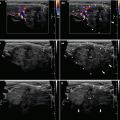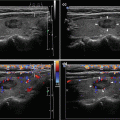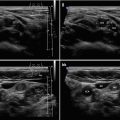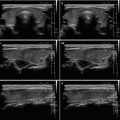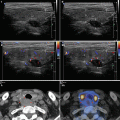and Zdeněk Fryšák1
(1)
Department of Internal Medicine III – Nephrology, Rheumatology and Endocrinology, Faculty of Medicine and Dentistry, Palacky University Olomouc and University Hospital Olomouc, Olomouc, Czech Republic
Keywords
TotalSubtotalNear total thyroidectomyThyroid tissue remnants20.1 Essential Facts
Total thyroidectomy (TT) has an important role in the management of patients with thyroid malignancy and benign disease involving both lobes of the thyroid gland. This approach avoids disease recurrence and the increased risk of morbidity associated with secondary operation. The incidence of complications with TT is similar to that with other techniques (subtotal and “near” total thyroidectomy). Therefore, TT is considered the gold standard of thyroid surgery [1].
Bron et al., between 1988 and 2002, performed 834 total thyroidectomies (706 women, 128 men) for clinically benign disease. Indications for surgery were 730 (87%) euthyroid multinodular goiter (MNG), 57 (7%) toxic MNG, and 47 (6%) Graves’ disease. A total of 74 patients had previously undergone partial thyroidectomy. The incidence of temporary recurrent laryngeal nerve palsy was 2.3% and the incidence of temporary hypoparathyroidism was 14.4%. Permanent recurrent laryngeal nerve palsy occurred in 1.1%, and 2.4% of patients had permanent hypoparathyroidism. Neither the initial clinical diagnosis nor a history of previous surgical treatment significantly influenced the rate of complications. The incidence of malignancy, other than incidental microscopic papillary carcinoma, was 4.6% [2].
The extent of thyroidectomy in Grave’s disease (GD) is still controversial. TT requires thyroxin replacement therapy throughout the patient’s life. The subtotal thyroidectomy aims to maintain long-term euthyroidism without thyroxine replacement therapy. However, these remnants entail the risk of hyperthyroidism recurrence. The surgical outcomes of Sugino et al. showed: patients with thyroid remnant of 7 g, 6 g, or 5 g had the relapse in 14.1%, 12.6%, and 10.9% respectively. None of the patients with remnant that weighed <2 g developed recurrent hyperthyroidism. Subtotal thyroidectomy leaving 3 to 4 g remnant tissue is a suitable surgical option for GD to avoid permanent hypothyroidism, and has low risk of recurrence rate 4% [3].
Primary treatment of differentiated thyroid carcinomas (DTCs) generally comprises a combination of surgery and radioiodine 131I ablation. This intensive approach consists of TT and central lymphadenectomy in all cases, completed by modified lateral lymphadenectomy. Thyroid remnant radioiodine ablation is routinely given to the vast majority of, if not all, DTC patients to destroy every source of uptake. Adjuvant radioiodine should be given, however, to complete, not to replace, total thyroidectomy [4].
Thyroid remnants with volume <2 mL could be seen on US at the earliest a month after the total or near-thyroidectomy. Thyroid remnants smaller than 2 g (<2 mL) facilitate use of postoperative radioiodine ablation [5, 6].
Lobectomy (Fig. 20.3) was previously used for solitary benign nodules. Endoscopic neck surgery for the parathyroid and thyroid was developed by Gagner and Huscher in 1996 and 1997, respectively. This method is currently known as minimally invasive video-assisted technique (MIVAT). Generally, endoscopic thyroid surgery has been thought to be appropriate for benign thyroid disease. Initially, it was indicated for nodules ≤3 cm, benign or low-grade follicular lesion, and papillary carcinoma, with contraindications for previous neck surgery, large goiter, local metastases, previous neck irradiation, thyroiditis, and hyperthyroidism. These indications during the development of this technique slightly changed. Nowadays it could be performed nodules ≥5 cm, for Graves’ disease, and thyroiditis. The role of endoscopy for carcinoma is still under debate [7].
Preoperative US with precise volume measurement of thyroid, lobe, or node, and subsequent FNAB and cytology are crucial for the choice of surgical approach.
20.2 US Findings of Thyroid Remnants
Post thyroidectomy, the carotid artery and jugular vein slide medially into the space previously occupied by the thyroid gland. The normal postoperative thyroid bed should have a uniform echogenic texture owing to fibrofatty connective tissue (Fig. 20.2). The left thyroid bed is often occupied by the esophagus [8].
TT and “near” total thyroidectomy (“near” TT) are associated with a low rate of recurrence. Subtotal thyroidectomy, in which a portion of the thyroid gland is deliberately left in the thyroid bed, has a considerably higher rate of recurrence. The incidence of complications with TT and “near” TT is similar to that with other techniques of thyroid surgery. However, despite the radical intent of surgeons, a real TT is not always carried out. The complete removal of all the thyroid tissue employing TT is not the norm, and micro/macroscopic remnants almost always remain. D’Andrea et al., in a US and CFDS study of 102 patients who had undergone TT for benign thyroid pathologies, demonstrated significant thyroid tissue remnants in the thyroid lodge in 34 cases (≈33%). Therefore, out of a total of 102 so-called “total thyroidectomies,” only 68 (≈66%) were really total, whereas 12 patients (≈12%) had near-total thyroidectomy, leaving tissue remnants <1 cm, and 22 patients (≈22%) had subtotal thyroidectomy, with tissue remnants ≥1 cm [1].
Recommendation for US follow-up after thyroidectomy [1]: all patients should be re-examined 6 months after the operation with a US and CFDS of the thyroid lodge and reclassified on the basis of tissue remnants as follows:
Total Thyroidectomy (TT) = absence of macroscopic thyroid tissue remnants (Fig. 20.1).
Near Total Thyroidectomy (“near” TT) = presence of thyroid tissue remnants <1 cm (Figs. 20.4, 20.5, and 20.7).
Stay updated, free articles. Join our Telegram channel

Full access? Get Clinical Tree



